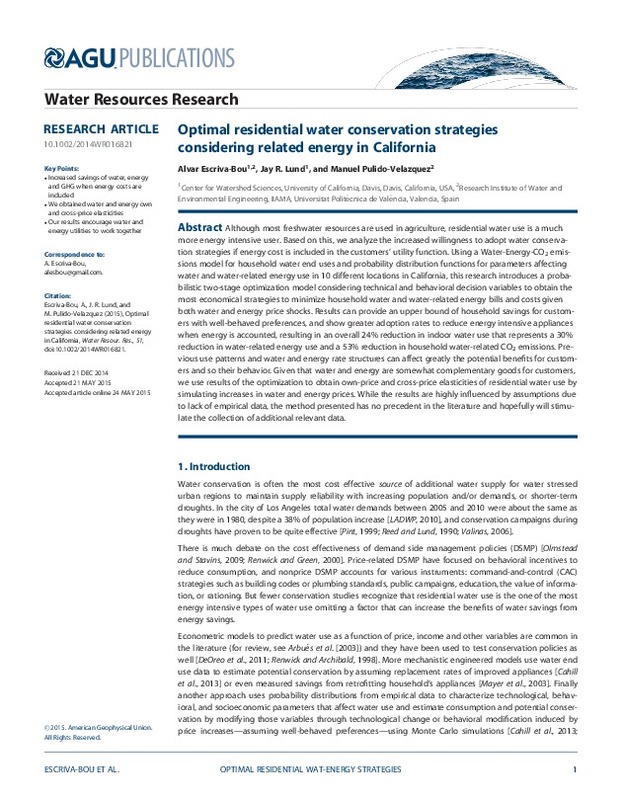JavaScript is disabled for your browser. Some features of this site may not work without it.
Buscar en RiuNet
Listar
Mi cuenta
Estadísticas
Ayuda RiuNet
Admin. UPV
Optimal residential water conservation strategies considering related energy in California
Mostrar el registro sencillo del ítem
Ficheros en el ítem
| dc.contributor.author | Escrivà Bou, Àlvar
|
es_ES |
| dc.contributor.author | Lund, JR.
|
es_ES |
| dc.contributor.author | Pulido-Velazquez, M.
|
es_ES |
| dc.date.accessioned | 2017-01-27T18:52:40Z | |
| dc.date.available | 2017-01-27T18:52:40Z | |
| dc.date.issued | 2015 | |
| dc.identifier.issn | 0043-1397 | |
| dc.identifier.uri | http://hdl.handle.net/10251/77421 | |
| dc.description.abstract | Although most freshwater resources are used in agriculture, residential water use is a much more energy intensive user. Based on this, we analyze the increased willingness to adopt water conservation strategies if energy cost is included in the customers' utility function. Using a Water-Energy-CO2 emissions model for household water end uses and probability distribution functions for parameters affecting water and water-related energy use in 10 different locations in California, this research introduces a probabilistic two-stage optimization model considering technical and behavioral decision variables to obtain the most economical strategies to minimize household water and water-related energy bills and costs given both water and energy price shocks. Results can provide an upper bound of household savings for customers with well-behaved preferences, and show greater adoption rates to reduce energy intensive appliances when energy is accounted, resulting in an overall 24% reduction in indoor water use that represents a 30% reduction in water-related energy use and a 53% reduction in household water-related CO2 emissions. Previous use patterns and water and energy rate structures can affect greatly the potential benefits for customers and so their behavior. Given that water and energy are somewhat complementary goods for customers, we use results of the optimization to obtain own-price and cross-price elasticities of residential water use by simulating increases in water and energy prices. While the results are highly influenced by assumptions due to lack of empirical data, the method presented has no precedent in the literature and hopefully will stimulate the collection of additional relevant data. | es_ES |
| dc.description.sponsorship | This paper has been developed as a result of a mobility stay funded by the Erasmus Mundus Programme of the European Commission under the Transatlantic Partnership for Excellence in Engineering-TEE Project. Water end-use data were kindly provided by Aquacraft Inc. who are able to release the data under private agreements and to whom we are very grateful. | en_EN |
| dc.language | Inglés | es_ES |
| dc.publisher | American Geophysical Union (AGU) | es_ES |
| dc.relation.ispartof | Water Resources Research | es_ES |
| dc.rights | Reserva de todos los derechos | es_ES |
| dc.subject.classification | INGENIERIA HIDRAULICA | es_ES |
| dc.title | Optimal residential water conservation strategies considering related energy in California | es_ES |
| dc.type | Artículo | es_ES |
| dc.identifier.doi | 10.1002/2014WR016821 | |
| dc.rights.accessRights | Abierto | es_ES |
| dc.contributor.affiliation | Universitat Politècnica de València. Escuela Técnica Superior de Ingenieros de Caminos, Canales y Puertos - Escola Tècnica Superior d'Enginyers de Camins, Canals i Ports | es_ES |
| dc.description.bibliographicCitation | Escrivà Bou, À.; Lund, J.; Pulido-Velazquez, M. (2015). Optimal residential water conservation strategies considering related energy in California. Water Resources Research. 51(6):4482-4498. doi:10.1002/2014WR016821 | es_ES |
| dc.description.accrualMethod | S | es_ES |
| dc.relation.publisherversion | www.dx.doi.org/10.1002/2014WR016821 | es_ES |
| dc.description.upvformatpinicio | 4482 | es_ES |
| dc.description.upvformatpfin | 4498 | es_ES |
| dc.type.version | info:eu-repo/semantics/publishedVersion | es_ES |
| dc.description.volume | 51 | es_ES |
| dc.description.issue | 6 | es_ES |
| dc.relation.senia | 303864 | es_ES |
| dc.contributor.funder | European Commission | es_ES |
| dc.contributor.funder | Erasmus+ | es_ES |








